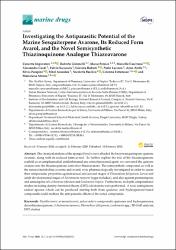Investigating the Antiparasitic Potential of the Marine Sesquiterpene Avarone, Its Reduced Form Avarol, and the Novel Semisynthetic Thiazinoquinone Analogue Thiazoavarone

View/
Date
2020Author
Imperatore, ConcettaGimmelli, Roberto
Persico, Marco
Casertano, Marcello
Guidi, Alessandra
Saccoccia, Fulvio
Menna, Marialuisa
Avunduk, Sibel
Metadata
Show full item recordAbstract
The chemical analysis of the sponge Dysidea avara afforded the known sesquiterpene quinone avarone, along with its reduced form avarol. To further explore the role of the thiazinoquinone scaffold as an antiplasmodial, antileishmanial and antischistosomal agent, we converted the quinone avarone into the thiazinoquinone derivative thiazoavarone. The semisynthetic compound, as well as the natural metabolites avarone and avarol, were pharmacologically investigated in order to assess their antiparasitic properties against sexual and asexual stages of Plasmodium falciparum, larval and adult developmental stages of Schistosomamansoni (eggs included), and also against promastigotes and amastigotes of Leishmania infantum and Leishmania tropica. Furthermore, in depth computational studies including density functional theory (DFT) calculations were performed. A toxic semiquinone radical species which can be produced starting both from quinone- and hydroquinone-based compounds could mediate the anti-parasitic effects of the tested compounds.

















